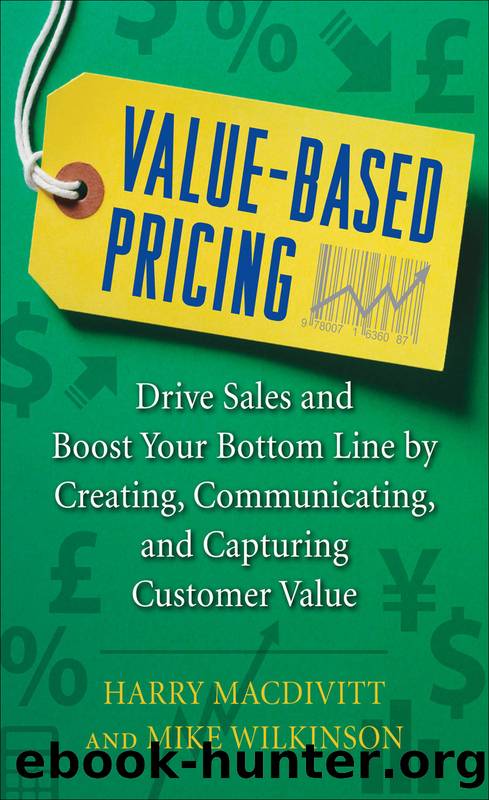Value-Based Pricing by Harry Macdivitt & Mike Wilkinson

Author:Harry Macdivitt & Mike Wilkinson
Language: eng
Format: epub
Publisher: McGraw Hill LLC
Published: 2012-04-15T00:00:00+00:00
CHAPTER 8
Building the Value Proposition
I bet your mother knows where the money is, and what you did to get it!
âPsycho (1960)
The value proposition (VP) concept made its appearance in the midâ1980s. Until then, we didnât have value propositions as such, and certainly no one told us about them when we were young salesmen. We did have other approaches, though. We used to call themâand still doâelevator pitches, key phrases, opening benefit statements, and key messages, and many people still use these approaches. They tend to focus on a features- and benefits-driven statement of customer outcome. As a result, they are not value propositions in the fullest sense of the term, but when they are used, they âkind ofâ work. In an unsophisticated way, they communicate why the customer should consider using us. Many of these approaches are now inaccurately called value propositions, but as we will see, there is much more to a well-crafted value proposition.
The most important thing we need to understand about todayâs VP is that it is a concise summary statement of why the buyer should choose our product or service in preference to that of a competitor. It must be able to answer the question, âWhy should I select your product or service rather than your competitorâs, and what additional value will I enjoy as a result?â This needs to be articulated convincingly and compellingly. This means that it must focus on the real needs and pain points of the buying organization and offer a believable and practical solution to that organization. A VP statement needs to use understandable and unambiguous language that is meaningful to the customer and the individuals who make up the customerâs buying decision-making team. It must be provable in the sense that it is based on some visible and demonstrable element of uniqueness your company possesses (and, of course, ideally that your competitor does not possess or at least not to the degree that your company does).
In order to put the VP into clear context, letâs set the scene with a charming little story: Once upon a time, a father went shopping for a pony to buy for his daughter. After looking at dozens of little horses, the man and his daughter narrowed the choices down to two ponies. They seemed identical in every respect. Even the prices were the same. Unable to make up their minds, they decided to take a second look at both ponies.
The first farmer, eager to make the sale, talked on and on about how gentle, how smart, and how cute his pony was. A classic features- and benefits-style approach. The father thanked him and went on his way. The second farmerâs approach was completely different. Instead of bragging about his product, he simply said, âLook mister, Iâm so sure your little girl is going to love this pony, hereâs what I suggest. Give me a check, and Iâll hold it for 30 days. Iâll bring the pony, a bridle and saddle, and 30 days of hay to your house.
Download
This site does not store any files on its server. We only index and link to content provided by other sites. Please contact the content providers to delete copyright contents if any and email us, we'll remove relevant links or contents immediately.
| Direct | Global |
| Industrial | Multilevel |
| Product Management | Research |
| Telemarketing | Web Marketing |
Influence: The Psychology of Persuasion by Robert B. Cialdini(4572)
The Miracle Morning by Hal Elrod(4391)
The Hacking of the American Mind by Robert H. Lustig(4051)
Pre-Suasion: A Revolutionary Way to Influence and Persuade by Robert Cialdini(3942)
Unlabel: Selling You Without Selling Out by Marc Ecko(3449)
Ogilvy on Advertising by David Ogilvy(3289)
Hidden Persuasion: 33 psychological influence techniques in advertising by Marc Andrews & Matthijs van Leeuwen & Rick van Baaren(3267)
Purple Cow by Seth Godin(3045)
Who Can You Trust? by Rachel Botsman(3013)
Kick Ass in College: Highest Rated "How to Study in College" Book | 77 Ninja Study Skills Tips and Career Strategies | Motivational for College Students: A Guerrilla Guide to College Success by Fox Gunnar(2976)
This Is Marketing by Seth Godin(2877)
I Live in the Future & Here's How It Works by Nick Bilton(2817)
The Marketing Plan Handbook: Develop Big-Picture Marketing Plans for Pennies on the Dollar by Robert W. Bly(2762)
The Power of Broke by Daymond John(2741)
Building a StoryBrand by Donald Miller(2736)
The 46 Rules of Genius: An Innovator's Guide to Creativity (Voices That Matter) by Marty Neumeier(2652)
Draw to Win: A Crash Course on How to Lead, Sell, and Innovate With Your Visual Mind by Dan Roam(2618)
The Tipping Point by Malcolm Gladwell(2527)
Market Wizards by Jack D. Schwager(2518)
